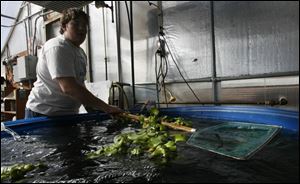
Aquariums filled with commercial fish for studies at Pettisville
3/22/2006
Sophomore Bryce Stilwill removes some tilapia out of the Pettisville High School aquarium in the school s greenhouse.
Something s fishy in the Pettisville High School greenhouse.
In a 400-gallon tank, students aren t cultivating carp they re taking care of tilapia, a tender white fish that can set your wallet back $18 a plate.
So far, Pettisville-raised tilapia haven t been sold to restaurants, but students have sampled the finned ones at a fish fry or two.
For the last few years, the fish tank has been making waves with Pettisville s aquaculture activities. Schools of fish are swimming around in other schools too, including Bowling Green High School and Clay High School in Oregon.
At Clay, perch and largemouth bass are being raised in 650-gallon and 400-gallon tanks. In other years, tilapia and catfish have been grown there. The aquaculture activities tie into classes about wildlife of Ohio and introduction to fishes in Ohio, said Charlie Schneider, environmental and agricultural technologies teacher.
Before summer break, school s out for the fish, and students gather for a taste of the class project. About 50 to 100 fish are served at the annual fish fry. Typically, that is. The catfish never made it to the pan. Those fish lasted only a short period of time before dying off from a disease.
As part of the high school s aquaculture unit, Clay students also raise fish in about 40 aquariums, said Mr. Schneider, noting that ornamental fish is big business. Students sometimes conduct feeding experiments, and they do fish breeding.
Information from the Ohio Aquaculture Association is used by the students, he said. With Ohio importing millions of pounds of farm-raised fish from other states, there s a potential for people to have jobs raising fish in this state, he said. Some Ohio farmers are raising fresh-water shrimp.
This is Clay s first attempt at a two-year project: raising largemouth bass. It s a big time commitment, the teacher said, and it s possible that the teacher and the students could decide in May to put the bass into a pond and be done with them.
Pettisville High s tank is in the school s greenhouse, where the fish enjoy the warm water, said sophomore Bryce Stilwill, who s hooked on the project.
We have a couple hundred fish in there, he said, scooping tilapia into a net. The goal is to get them to reproduce. They re thumb-nail size when they re born. Tilapia can be found in the Red Sea, where the largest recorded tilapia tipped the scales at 36 pounds, he said.
This marks the first year that a lot of fingerlings have survived more than a few days. Alas, poor parenting skills apparently have killed off many babies. When a just-born tilapia gets cold or scared, it swims into its mom s mouth. Sometimes the moms accidentally swallow the little fish, said young Bryce.
High protein fish food is served to the fish, and water lilies floating on the surface provide a tasty side salad. A large insulated shade on the tank blocks the sun and reduces algae growth. They like the water dark, said young Bryce, who would like to raise tilapia as a money-making venture at his home.
In addition to reeling in students interest in aquaculture job opportunities, the project provides John Poulson, FFA adviser and agriculture teacher, with a handy teaching tool for such topics as water quality, plant sciences, and environmental sciences. The nitrogen cycle is easy to teach out of it, he said.
Tilapia should go from zero to one pound in six months, but ours are growing slower. Part of that is because of the tank size; part is condition. We don t have an automatic feeder, Mr. Poulson said. Students feed the fish six times during the day, but tilapia are nocturnal and are awake looking for midnight snacks.
Raising fish has turned into a year-round activitity. During the summer, a student or Mr. Poulson feeds the tilapia and cleans the tank.
The plan was to raise the fish and then harvest them, the teacher said. So far that hasn t worked out.
Contact Janet Romaker at: jromaker@theblade.com. or 419-724-6006